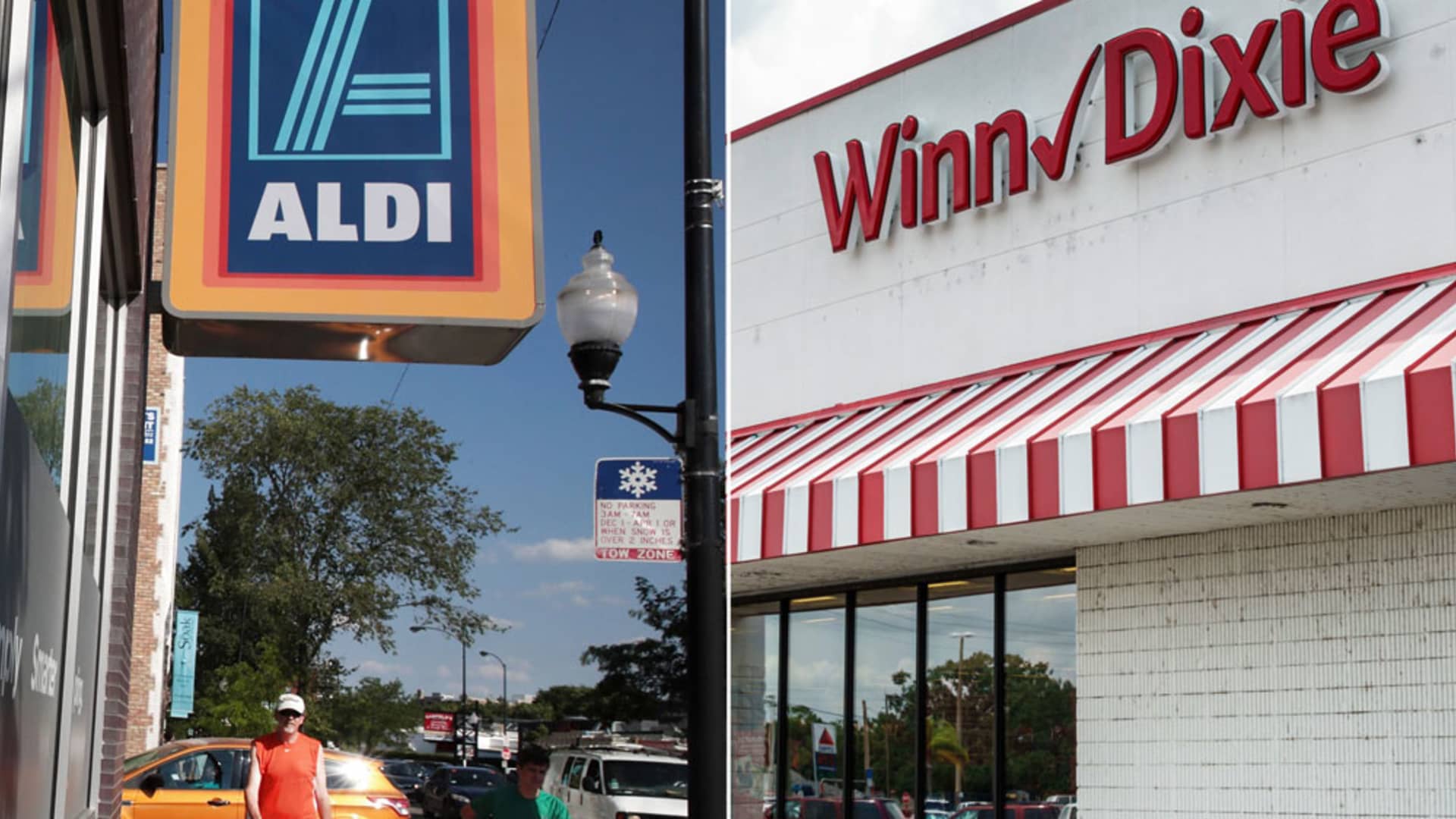Aldi is getting bigger. Here’s why the no-frills German grocer is looking to the Southern U.S. for growth

Getty Images
No-frills discounter Aldi is the latest grocer to shake up the industry with big moves.
The German retailer announced this week that it plans to acquire about 400 Winn-Dixie and Harveys Supermarket locations across the Southern U.S. As part of the deal, it would take over operations of the stores, which are in Florida, Alabama, Georgia, Louisiana and Mississippi, and put at least some of them under the Aldi name.
The deal is expected to close in the first half of next year.
Aldi is already expanding aggressively across the country. It has more than 2,300 stores across 38 states. Separate from the acquisition, it is on track to open 120 new stores by year-end.
The proposed deal comes as Kroger‘s $24.6 billion acquisition of Albertsons is pending. Companies including Amazon and Target are also trying to snap up more grocery market share as inflation-weary consumers continue to buy food and essentials but become more frugal when it comes to other merchandise like clothing and electronics.
Like Trader Joe’s and fellow Germany-based rival Lidl, Aldi relies heavily on its own brands. About 90% of products it carries are Aldi’s private label, which allows it greater scale and lower costs in areas like marketing and the supply chain. Aldi also gets creative to keep costs low, including by reducing the size of a pasta sauce lid and other packaging and using electronic shelf labels that save on labor and materials.
As inflation cools, that could present a new challenge for Aldi — if shoppers revert to old habits like shopping at neighborhood grocery stores that may have higher prices, or opt for a favorite name-brand cereal or more variety. It’s also had to race to keep up with competitors’ online options, prompting Aldi to expand curbside pickup to more stores.
The privately held retailer did not share financial details of the acquisition. But the deal has big implications for publicly traded competitors including Walmart and Kroger, as well as regional grocers.
CNBC spoke to Jason Hart, the CEO of Aldi U.S., about why the company is doing the deal and how it sees Aldi fitting into a fast-changing grocery landscape. His comments were edited for brevity and clarity.
Why was Aldi interested in acquiring Winn-Dixie and Harveys Supermarket? Why acquire rather than build your own hundreds of stores in similar locations?
This acquisition provides us speed to market with quality retail locations, great people and a solid core business in a region of the country, the Southeast, where we’ve already had and experienced significant growth and success, but we also see much more opportunity and there’s much more consumer demand to meet.
Doing this [expanding] on our own organically, that has been our plan, and that has been our trajectory over a number of years, and in the Southeast as well. …. This acquisition really gives us the opportunity to accelerate all of those plans.
Jason Hart, Aldi U.S. CEO
ALDI Creative Quarter Studio/ Katrina Wittkamp
What should shoppers expect to see at those stores on the other side of the acquisition?
We’re currently evaluating which locations we’ll convert to the Aldi format to better support the communities that we’ve now got the opportunity to serve more closely. We’re going to convert a significant amount to the Aldi format after the transaction is closed and over the course of several years.
For those stores we do not convert, our intention is that a meaningful amount of those will continue to operate as Winn-Dixie and [Harveys] Supermarket stores.
In stores that you choose not to convert with the acquisition, will people start to see some of those Aldi products on Winn-Dixie shelves?
We can certainly see and imagine some future synergies and learnings from each other, whether that’s consumer insights, product ideas, merchandising ideas, but at this point, we just don’t have any definitive plans to announce.
What do you think your stores offer that other players like Walmart, Kroger and even Dollar General don’t?
We carry a limited number of SKUs [stock keeping units, the term used to describe each type of product carried by a retailer] first and foremost — a couple of thousand SKUs in our stores versus our competition that may have many times that — that drives higher volume per SKU, driving scale that provides efficiency both in our business and for our suppliers.
The dozens of brands and sizes and small variants of the same product — the result of that [in rival stores] is tens of thousands of products that isn’t necessarily the result of customer demand. It’s more so the brand’s demand for shelf space within those stores. And the result actually can frustrate customers by overcomplicating the shopping experience. At Aldi, we simplify that shopping experience for the customer, offering great quality and great prices.
Why do you think we’re seeing so many big moves in the grocery industry right now?
The way that consumers are shopping is changing quite dramatically. And also the drive to value. And obviously, there are alternative retail formats that are growing quicker than the traditional formats. We’re very proud to be one of those alternative formats that’s really disrupting the industry.
Consumers seem to be willing to try other ways to fill their grocery list, whether that’s through e-commerce, whether that’s through trying out discounters like Aldi, [and] trying out different products like private label.
When consumers are seeing these changes, and seeing other retailers and other products meet their needs, they change their shopping habits.
What are the trends with online and in-store sales now as the pandemic is more in the rearview mirror?
We’re now seeing equal growth in both our bricks-and-mortar sales and in our e-commerce sales. I would anticipate if I was to look at the crystal ball of the future, it’s going to go back to e-commerce growing slightly more than what bricks and mortar is both in the market and for Aldi.
Source – CNBC




